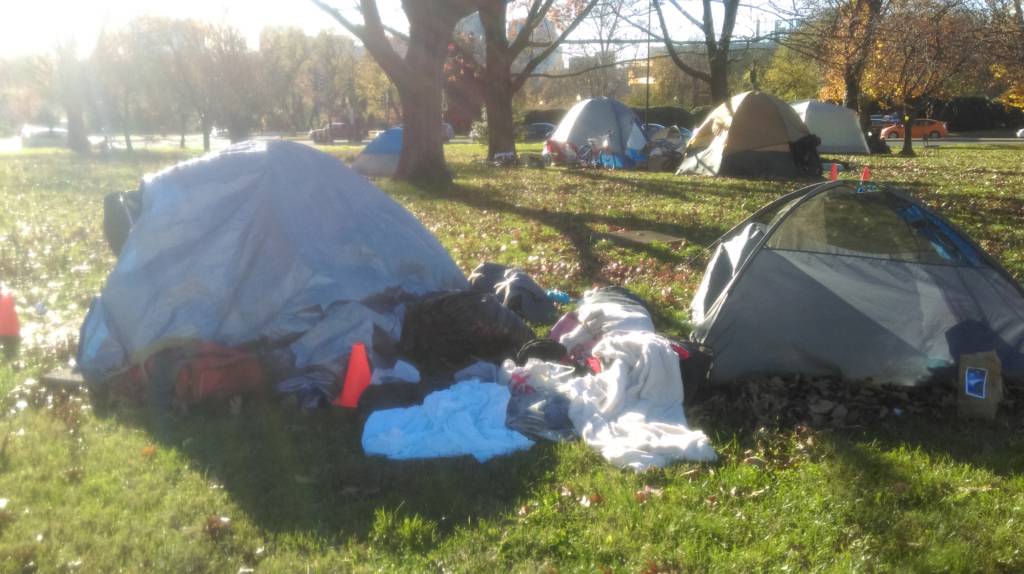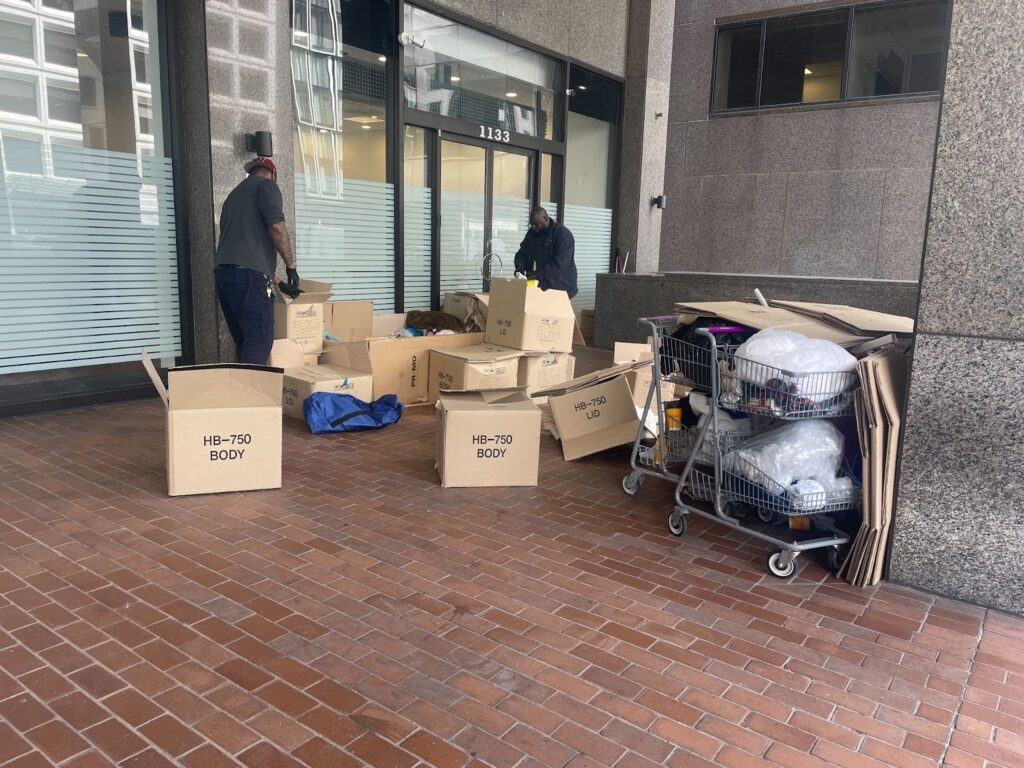For one night only, Wednesday, December 2, E Street Cinema will be screening the new documentary “Under the Bridge.”
“This film is to the criminalization of homelessness as Rodney King was to exposing police brutality,” said Don Sawyer, filmmaker and accidental advocate.
Sawyer credits co-writer Stephen Talbot—who holds 2 Emmys, 2 Peabody Awards and 2 duPont-Columbia Silver Batons for broadcast journalism—with overseeing the project from start to finish.
In the coming months, a team of the filmmakers including Sawyer, Emmy-winning editor and co-writer John MacGibbon and co-director Sam Mirpoorian will bring this Indianapolis-centered indie film to as many screens as possible, countrywide. The National Coalition for the Homeless and the National Law Center on Homelessness and Poverty are sponsoring a stop in Washington that includes a panel discussion after the screening.
Proceeds from the D.C. screening will help carry Sawyer and his colleagues to their next event in Boston.
“Under The Bridge” started as a simple re-edit of the film “Uncharted” that Sawyer co-produced with Mirpoorian in 2014, shortly after moving to Indianapolis.
“When I lived in Los Angeles, I would go down to skid row on a semi-regular basis, just taking clothing and having conversations with the people down there,” Sawyer explained. “But I’d never been an activist or an advocate in that way.”
After arriving in Indianapolis, similar habits led Sawyer to a camp of homeless folks living under a nearby bridge. He formed a relationship with the guy that ran it and they talked in passing about creating a YouTube channel to dispel stereotypes about homelessness and homeless people.
Mirpoorian and colleagues arrived at the camp independently to propose shooting a documentary to the camp leader. The YouTube plans were put on hold. Sawyer quickly formed a relationship with Mirpoorian and his group. They became a film crew.

“This criminalization issue wasn’t even on our radar,” Sawyer said. “We spent about 6 months in the camp before reaching out to service providers and the mayor’s office. We started doing interviews with these people that were entirely out of touch with what was going on.”
To criminalize homelessness is to outlaw basic acts of survival in public space, such as sharing food, sleeping or panhandling. The federal government is against such regulations, but state and city ordinances tell another story.
For instance, the National Law Center on Homelessness and Poverty’s “No Safe Place” report found that in 2014, 65 percent of cities banned loitering, loafing, and vagrancy in specific areas.
“We’re seeing efforts from cities to wrestle with homelessness, but they’re not responding with long-term systemic solutions,” said Megan Hustings, Director of the National Coalition for the Homeless (NCH). “They’re responding with punitive measures that do nothing to help the problem.”
Homelessness is on the rise, according to Hustings. The numbers don’t show it yet because it’s generally people that are not all that visible: people staying in hotels, cars, encampments and elsewhere.
“We just get more and more phone calls from people that are struggling. And we know things aren’t getting better.” Hustings said. “The sequestration alone cut 100,000 housing vouchers. The SNAP program is continually up for cuts. TANF benefits are set to expire for many people in the next year. There are a lot of programs that have been lifting people out of poverty that are continuously getting cut.”
The United States has massively de-invested in affordable housing and safety net programs. In 1979 the U.S. Department of Housing and Urban Development’s budget included $16 million for affordable housing. By 1983 that item was below $2 million. Now a growing number of people have nowhere to go.
John MacGibbon, formerly of PBS FRONTLINE, saw “Uncharted” when his sister hosted a screening. He called Sawyer and suggested some options for a re-edit to make the film more powerful. Sawyer raised funds and brought MacGibbon on board.
But after he saw what hadn’t made it into “Uncharted,” MacGibbion told Sawyer “I just cannot believe the footage you did not use. You don’t even get these types of interviews at frontline, we’ve got to make another film.”
The people of Indianapolis reacted swiftly to “Uncharted.” Several legislative attempts at a local ‘homeless bill of rights’ made varying degrees of headway. Proposal 291 even passed the city council, only to be vetoed by the mayor.
Sawyer hopes to attain a similar national reaction to “Under the Bridge,” and more meaningful change.
Before the release of “Uncharted,” local law enforcement cleared out the camp Sawyer and Mirpoorian documented.
“Some left town. Some just kinda disappeared, dropped off. A few of them are still around,” Sawyer said.
Initially, some people just went to other camps around town. But those camps were threatened with closure, too. Sawyer attributes a lot of these efforts to a period of major gentrification Indianapolis is going through.
“I’ve never seen a place build up this fast. The formula is build it up so people will come, but people don’t want to see the homeless, so hide the homeless,” Sawyer explained. “They don’t want big congregations of people who don’t have any place to be. They keep it hidden so people don’t have to see it when they come down to Colts games.”
The Department of Justice recently ruled on a case in Boise, Idaho, which would have made the Indianapolis bridge clean-up a violation of the eighth amendment, reported the Indianapolis Recorder. It would have been cruel and unusual punishment because the city provided nowhere for those campers to go.
Even if the city had offered shelter, that’s not a solution to get people off the streets, according to Megan Hustings. There are many reasons people choose to avoid shelters. Some folks who work can’t follow a shelter’s time restrictions. Some shelters take women and children but not men, and families don’t want to split up. Religious restrictions are not unheard of. There are a lot of barriers to accessing community shelters, and most shelters out there do not receive federal funding and are thus not required to follow federal guidelines on admission.
“The thing is, a lot of people are working, but they can’t find viable work,” Hustings said. Wages are way behind the times. The National Low Income Housing Coalition just released Out of Reach 2015, a report showing that there’s not a single state in the country where you can work 40 hours per week on minimum wage and afford decent housing.”
“Under the Bridge” is a film that happened in Indianapolis, but it’s the same story across the country, according to Sawyer.
True enough, Honolulu made national headlines when its governor cleared out one of the country’s largest homeless encampments. And Seattle created controversy when it announced city-sponsored homeless encampments.
On Monday November 16, during NCH’s National Hunger and Homelessness awareness week, District workers moved in to clear-out a long-standing encampment on Virginia Avenue in Foggy Bottom. At least 15 tents where visible next to Rock Creek Parkway and under Whitehurst Freeway.
While notice of the “cleanup” had been posted more than two weeks prior, and outreach workers had reminded campers of the upcoming action on Friday November 13 – unclear messaging left nearly all campers confused and frustrated come Monday. A protocol in the 2016 winter plan prohibits the seizure of blankets and other items that could keep a person warm during hypothermia season. That season began November 1st and lasts through February of next year. Meeting minutes from a District Interagency Coucnil on Homelessness workgroup that met the afternoon of the cleanup indicate that the written protocol it must be clarified to reflect whether or not tents fall into this category of protected items.
It is illegal in the District of Columbia to have any sort of “temporary abode,” such as a tent, without express permission of the mayor. But with nowhere for these homeless campers to go and winter approaching, it is a difficult situation. Eight of eight campers asked whether or not they would go to a shelter said no, citing lack of cleanliness, lack of safety, interference with work, and potential split up from romantic partners.
As of Tuesday November 17, Mayor Bowser maintained that the campers would have to leave. The tents were still there when Street Sense went to press.
“I believe that the average citizen of any city would not want to live in a place where it is illegal for any American citizen to exist,” Don Sawyer told Street Sense. “If a homeless individual cannot legally be on private property, and cannot legally rest on public property, they are by definition a criminal for being anywhere.”
Sawyer and his fellow filmmakers aim for one thing: raising awareness.
“Once we get [criminalization] out of the way, we can get on to this issue of how much cheaper it is to house people with supportive services than to provide them services on the street,” Sawyer said.
After over 30 years of operation, NCH still sees a great need to raise awareness about the realities of homelessness. Sharing this information with your friends and family actually makes a big difference, according to Hustings. Programs that build public education are effective at getting people involved in a meaningful way.
“I came out of the film energized to work harder, and angry at the system that keeps people living on the street,” Hustings said.
Continued updates at StreetSense.org/CampWatergate.
“Under the Bridge” will be screened at E Street Cinema at 7 p.m. on Wednesday, December 2.








